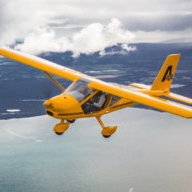Retrospective LSA
First, my understanding of the terms:
S-LSA = factory built LSA
E-LSA = amateur built 'experimental' LSA, even if just a few nuts & bolts are installed.
'Normal' RA-Aus = either Type Certified factory built, or amateur built recreational aircraft.
There is an important difference between 'normal' RA-Aus and S-LSA: 'normal' RA-Aus aircraft have to have a Type Certificate, issued by the CASA-equivalent of an 'acceptable' ICAO signatory country. Just through the history of recreational/ultralight aircraft development, many of these types are based on (or actually are) 450kgs MTOW aircraft as defined by many European countries.
Quite a few of these aircraft can be beefed up to handle more weight - but if so, they have to have a new Type Certificate at the new weight issued in an acceptable country. Many countries just do not have the legislation which allows Type Certificates to be issued over 450kgs MTOW unless the aircraft are fully GA-certified (ie expensive, so most do not). Some manufacturers have got round this problem by obtaining higher weight Type Certificates from countries in South America, the Middle East and a few other lesser known parts of the world.
Interestingly, the Czech Republic has a special system for approving recreational aircraft with over 450kgs MTOW, which may in part explain the relatively high frequency of Czech designs on the S-LSA list. My understanding is that the UK, Germany, Italy, France etc do not have legislation which enables certification of factory built ultralights over 450kgs (or 472.5kgs when fitted with a BRS).
S-LSAs are, in effect, certified by the manufacturer as compliant with all the ASTM design, manufacture and flight envelope specifications/regulations. Currently the limit for these aircraft is 600kgs (land) and 650kgs (water) or such lower limit as the manufacturer stipulates.
Thus, a Type Certified 450kgs (or 544kgs) aircraft cannot simply be boosted to 600kgs unless it has an acceptable Type Certificate at that weight. The only way for the manufacturer to go economically to 600kgs is the LSA route.
And there are differences between individual country Type Certificate requirements and between these and ASTM standards - not necessarily higher or lower standards, just different.
I have been told by Steve Bell at RA-Aus that S-LSA aircraft cannot be registered as 'normal' RA-Aus aircraft (whatever their weight limit) as they do not have a Type Certificate. So I think most 600kgs imported aircraft will have to be registered as LSAs if the owner wants to take advantage of the extra weight.
Finally, LSA or 'normal' RA-Aus aircraft not wholly built by the factory can only ever be 'experimental' registered and cannot be used for training. Although the occasional manufacturer has sought to get round this with 'factory-assist' build schemes and the like. Even factory built LSAs which have been modified without written factory agreement are 'demoted' to E-LSA and again cannot (ever) be used for training.







